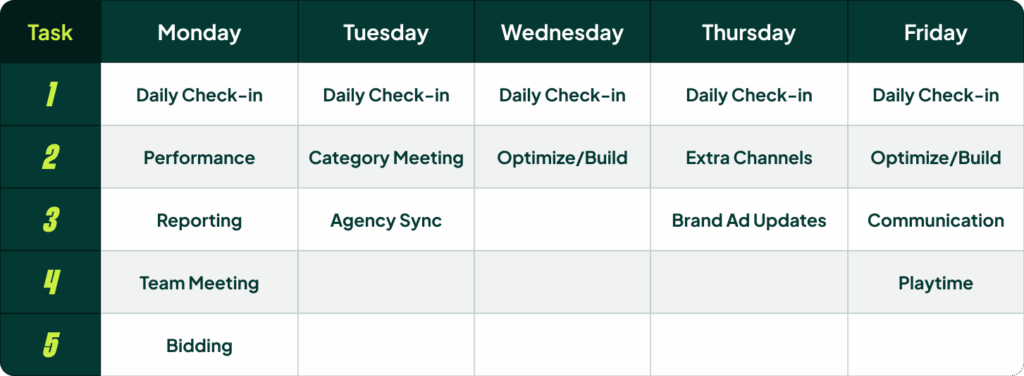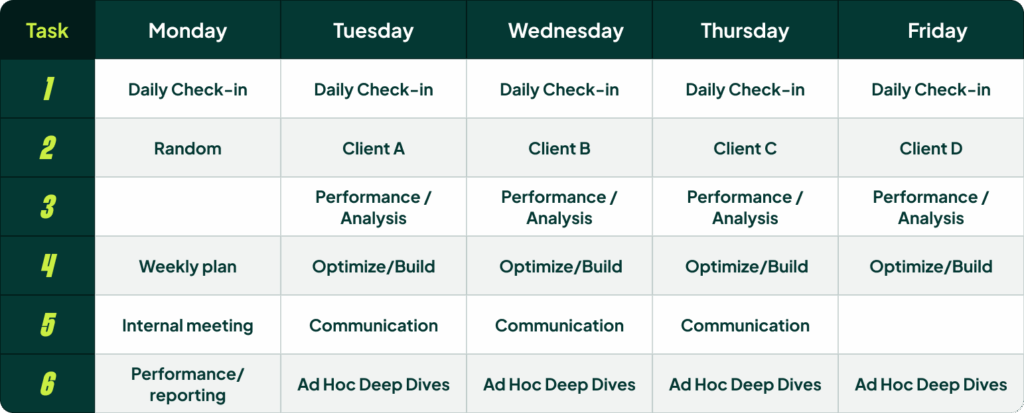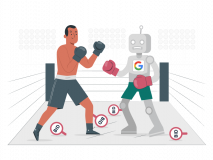If you’re managing Google Ads accounts, you know the drill. A hundred different tasks are flying at you every week. You’re constantly feeling like you’re reacting to fires, and when you look back at your week, you’re left wondering where the time actually went. Sound familiar?
What if I told you the secret to Google Ads productivity isn’t about working harder, but about implementing a bulletproof routine that gives you back control? That’s what I’ve been doing for the last 15 years. This system helps you stay on top of your accounts and gives you the framework to push back against all those time-wasting “urgent” requests from your boss, teammates, or clients.
But before we dive into the daily breakdown, we need to establish the foundation. Ignore these rules, and any attempt at a schedule will fall apart.
Go Beyond the Article
Why the Video is Better:
- See real examples from actual client accounts
- Get deeper insights that can’t fit in written format
- Learn advanced strategies for complex situations
The 10 Non-Negotiable Rules for a Productive Workflow
This entire system is built on a set of principles. If you ignore even one of them, you’ll sabotage every single effort you make to be more productive. Internalize these first.
- Know What Moves the Needle: For some accounts, fiddling with budgets and bids daily is pointless. For others, it’s the core of your job. Figure out the 20% of tasks that drive 80% of the results for your specific account and spend most of your time there.
- Analysis Must Lead to Action: Fancy reports are great. Deep analysis is wonderful. But if you don’t actually click a button in the interface to implement a change, performance will not improve. Analysis for the sake of analysis is a waste of time.
- Stop Doing a Little of Everything: Avoid switching contexts. Don’t do a little ad writing, then a little search term review, then a little optimization. Schedule focused blocks of time. An entire day for ad writing. A whole morning for bidding. This is how you get deep work done.
- Centralize Your Data: Fix your dashboards. In Savvy, we have a simple spreadsheet for each client with all the key data in one place—blended ROAS, margins, week-over-week, year-over-year. Stop wasting time jumping between five different platforms to get a simple answer.
- Automate Recurring Tasks: This should be obvious. Set up safety reports in Merchant Center so your feed doesn’t just disappear. Use scripts for bid management. And for goodness sake, disable Google’s automatic “optimizations” so you don’t wake up to find broad match suddenly running across your entire account.
- Take Notes (Two Kinds): This is one of my biggest rules. First, use the notes feature in Google Ads graphs. When you make a big change to bids, budgets, or campaign structure, add a note. It takes three seconds and will save you hours of guesswork later. Second, keep a personal log (I use Notion) of your thinking. Why did you make that change? What was your hypothesis?
- Bookmark Everything: Do not navigate to ads.google.com, find your MCC, search for the account, and then click through to a report every single time. It’s madness. Create bookmarks that take you directly to the accounts and reports you access frequently.
- Get Out of Recurring Executive Meetings: Especially weekly ones. They take forever to prepare for and are often a colossal waste of time. Proactive communication (more on that next) makes most of these meetings redundant.
- Be Proactive with Communication: This will reduce all other communication tasks by 80%. I’m not exaggerating. This is where in-house teams, in particular, tend to fail. Send a weekly update to your manager and key stakeholders. What’s the status of the current sale? What’s the plan for that new product launch? What happened with that test we discussed? A 30-minute summary email or a 10-minute Loom video will stop people from peppering you with a thousand random questions all week.
- Master Your Calendar: This underpins everything. Your calendar is your shield. It’s the tool you use to enforce your routine and protect your focus time.
The Anatomy of My Ideal Week: The 4 Core Buckets
Now, let’s look at the structure. This is an ideal week for someone with complete autonomy managing a single account. We’ll cover how to adapt this for the real world (agencies, in-house teams) in a moment, but this is the template.
- Monday: Performance Deep Dive, Bidding & Reporting
- Tuesday: Optimization & Building
- Wednesday: Optimization & Building
- Thursday: Performance Deep Dive & Ad-Hoc Tasks
- Friday: Communication & Playtime
This schedule revolves around four core buckets of work that I rotate through based on an account’s needs.
Bucket 1: Analysis
This includes your daily check-ins and weekly performance deep dives. The daily check-in is just that—a quick look to make sure nothing is broken. If you find a problem, don’t fix it right then. Add it to your task list and address it during your scheduled optimization time. The performance deep dive on Monday is more strategic: what’s underperforming, what’s overperforming, and what are we going to do about it?
Bucket 2: Optimization
This is the hands-on work of improving what already exists. The specific tasks depend on the account, but it includes things like search query reviews, negative keyword additions, ad copy testing, and audience refinement. You should have a checklist of your core optimization tasks that you run through regularly.
Bucket 3: Building
I separate this from optimization because the mindset is different. Building is about creating something new—a new campaign for a product launch, a new asset group for Performance Max, a new ad strategy. It’s creative and strategic, whereas optimization is more iterative and analytical.
Bucket 4: Playtime
This is non-negotiable, even if it’s just an hour a week. This is where you learn. You test new scripts, watch YouTube videos (like mine, hopefully), play with ChatGPT to write ad copy, and explore new platform features. If you don’t schedule time to learn, you will fall behind. I try to build this into my optimization and build time, but dedicating a specific block is even better.
How to Customize This Routine for Your Role
That “ideal week” is a starting point. Your reality is probably messier. Here’s how to adapt it.
For In-House Teams: Taming the Chaos
If you’re in-house, you have more meetings and are probably pulled into work on other channels. The key is to batch the chaos. Fight to get all your meetings on a single day. Don’t let your week get chopped up by a team meeting on Monday, an agency sync on Tuesday, and a category manager update on Wednesday. A week might look like this:
- Monday: Performance, Bidding, Reporting.
- Tuesday: Meeting Day. Get them all done. Agency syncs, internal meetings, everything. It will be a draining day, but it frees up the rest of your week.
- Wednesday: Focused Google Ads Day. Head down, no distractions. Optimize and build.
- Thursday: Ad-Hoc & Other Channels Day. Handle all the random requests from the brand team and work on your other channels.
- Friday: Focused Google Ads Day. Nobody bothers you on Friday, so it’s a perfect day for deep work. End the day by sending out your proactive communication report.
For Agencies & Freelancers: Juggling Multiple Clients
At an agency, the week shrinks to a day. The goal is to dedicate entire days, or at least half-days, to a single client. This stops the constant context switching that kills efficiency.
Your week might be structured by client: Client A gets Tuesday, Client B gets Wednesday, etc. On that day, you run through the same buckets: analysis, optimization, building, and reporting for that one client. This focus is incredibly powerful.
It might seem like an agency manager with five clients gets less time per account than an in-house person, but that’s rarely true in practice. Why? Because agency teams are built for efficiency. We do the same things over and over, have dedicated tools, and can distribute learnings across accounts. We don’t get pulled into nearly as many random meetings.
The Real Secret? You Have to Protect Your Schedule
Here’s the most important part. You can have the most beautiful schedule in the world, but it’s useless if you don’t enforce it. A schedule isn’t just a plan; it’s a communication tool.
When your manager comes to you and asks, “Hey, can you do XYZ today?” you don’t just say “No.” You look at your schedule and say, “I can absolutely do that. I’m focused on campaign optimization today based on our performance goals, but I have a block for ad-hoc tasks on Thursday. I can schedule it for then. Does that work?”
Most of the time, people will respect a plan. Half the battle for in-house managers is that their week is consumed by tasks that have nothing to do with managing their channel. A structured, visible plan is your best defense against that.
[TL;DR]
- Create a schedule. Plan your week with dedicated blocks for specific types of work (analysis, optimization, building). Batch meetings and ad-hoc requests onto specific days to protect your focus time.
- Enforce your schedule. A schedule is a tool for managing expectations. Use it to communicate your priorities and negotiate deadlines for incoming requests instead of letting them derail your day.
- Communicate proactively. Spend 30 minutes a week sending a summary of performance, actions taken, and next steps. This will eliminate a huge number of reactive questions and build trust with stakeholders.
- Focus on what moves the needle. Not all tasks are created equal. Identify the highest-impact activities for your accounts and dedicate the majority of your focused time to them.









